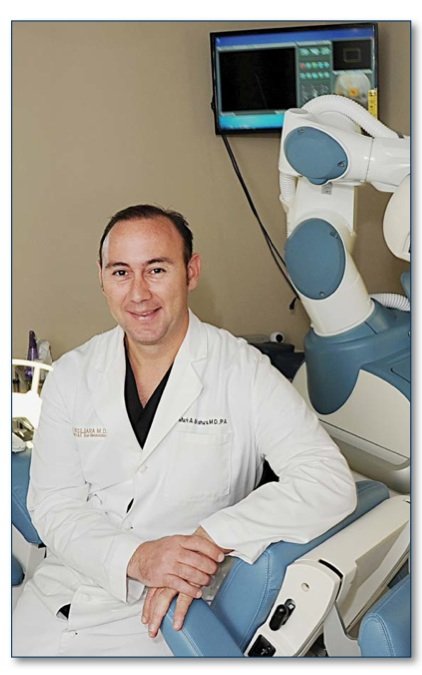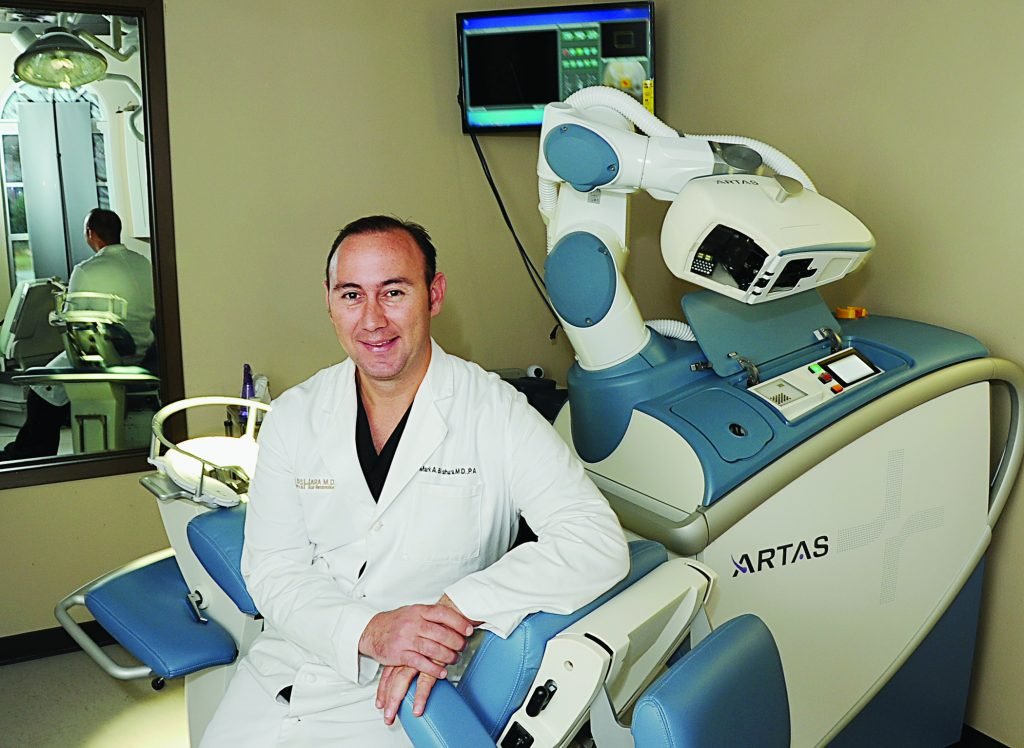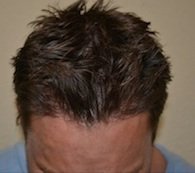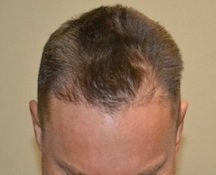Recently, Restoration Robotics launched ARTAS Hair Studio. This state of the art product allows the patient and surgeon plan and produce a simulation of a possible outcome. Although this product has some limitations to the realistic look of the transplanted hair, it does allow for a formal interaction between the surgeon and the patient that spawns more thought into the over- all operative goal and leads to increased numbers of hairs being transplanted.
The most common cause of dissatisfaction of hair transplant patients in my practice and in patients that come to me from other practices is that they didn’t get the thickness that they wanted. The ARTAS Hair Studio allows the patient to “Test Drive” their appearance and modify the operative plan under the guidance of the surgeon. It becomes the surgeon’s ethical and responsible role to provide guidance on safe and age appropriate hairline design, donor capacity, and realistic expectations on social and physiologic downtime. The ARTAS Hair Studio becomes paramount providing a sneak preview to esthetic results that vary with amount of hair.
Put together with a well informed consult discussing preventative hairless measures backed by randomized double-blinded placebo controlled trials, the ARTAS Hair Studio is quickly becoming the standard of care in hair restoration planning and patient education.
ARTAS Hair Studio also integrates directly with the robot and becomes the operative plan for the patient ensuring that the patient is receiving exactly what he is intending to recieve.
For a consultation please call 817-473-2120 or email [email protected]. Skype and other internet-based consultations are available.
Mark A Bishara M.D., P.A. and Paragon Hair Clinics care for patients world-wide.
Dr. Mak A Bishara, M.D. P.A. performs robotic follicular unit graft selection for residents living around Mansfield, Southlake, Dallas, Arlington, Fort Worth, and surrounding the DFW area in North Texas.
Posts

Dr. Bishara’s office locations in Mansfield and Southlake, TX have also added this important step in the Follicular Unit Extraction (FUE) procedure, a step that until now needed to be performed by hand. The goal of the new function is for the robot to automatically obtain the maximum number of donor hairs with the least amount of wounding and the greatest cosmetic benefit for the patient. Dr. Bishara is the only doctor in Texas that offers Graft Site Selection.
How Does it Work?
Using robotic graft selection, the hair restoration surgeon programs the ARTAS robot to harvest follicular units which contain two or more hairs by selectively skipping over the 1-hair units. Using its advanced optical guidance system, the robot orients itself to the scalp by way of special markings on a tensioner, a plastic frame-like device that is positioned on the donor area. The software then rapidly analyzes each graft and selects the appropriate ones for extraction. It then dissects these follicular units from the surrounding scalp tissue.
The Importance of Graft Selection in FUE
In FUE hair transplant procedures, the surgeon wants to harvest as much donor hair as possible while leaving the fewest number of wounds. To minimize the number of wounds, you would want to extract only the units that contain the largest amount of hair. However, smaller grafts of 1-hair are typically needed to create a natural-looking hairline and temples. By selecting and extracting larger grafts first, and then extracting smaller ones only as needed, surgeons can both minimize wounding and harvest an adequate number of follicular units of varying size so as to enhance the cosmetic benefit of the procedure. Smaller grafts can be generated by dividing the larger grafts without increasing the donor wounding.
This News is brought to you courtesy of Dr. Bishara and The Paragon Plastic Surgery & Med Spa


(Before and After Pictures of one of our patients)
For the right patient, exhibiting the right hair and scalp characteristics, hair transplant surgery can be a life changing cosmetic procedure. However, not every hair loss sufferer is a good candidate for surgical hair restoration. It’s important to fully understand the criteria that makes a good hair transplant candidate in order to make a better informed decision when considering surgical hair restoration.
The best way to find out if you are a candidate for a hair restoration procedure is to go to a dermatologist or plastic surgeon specializing in hair restoration. The answer will depend on the cause of your hair loss, your age, the stability of your donor supply, how extensive you hair loss is, your expectations and a number of other important factors that will be taken into account.
For the right candidate hair restoration surgery can significantly improve your appearance and general sense well being. You must have realistic expectations before undergoing a hair transplant procedure.
Here are some general types of patients that are great candidates for hair transplants:
The best candidates for hair restoration surgery are:
- Men who have been losing their hair due to Male Pattern Baldness for more than five years or who have progressed to a Norwood class 3 or above.
- Men with realistic expectations and who understand that their hair loss might continue to progress even if they are taking prescription medication to stop the progression.
- Men who have been balding for many years and who’s pattern has stabilized and are interested in just adding some hair to provide a more youthful appearance.
- Men and women who have lost hair due to trauma or burns
- Men and women who have lost hair due to other cosmetic procedures such as face-lifts.
Some women are candidates for hair restoration surgery. They are:
- Women who have suffered hair loss due to mechanical or traction alopecia (non-hormonal).
- Women who have had previous cosmetic or plastic surgery and are concerned about hair loss around the incision sites.
- Women who have a distinct pattern of baldness, similar to that of male pattern baldness. This includes hairline recession, vertex thinning (on the crown or top of the scalp), and a donor area that is not affected by androgenetic alopecia.
- Women who suffer hair loss due to trauma, including burn victims, scarring from accidents, and chemical burns.
- Women with alopecia marginalis, a condition that looks very similar to traction alopecia.

Please visit the website of Dr. Bishara, who specializes in Hair Restoration, Robotic Hair Transplants and Plastic Surgery at www.MarkBisharaMD.com or call our office at (817) 473-2120.
en Español
(Antes y después de las imágenes de uno de nuestros pacientes)
Para el paciente adecuado, mostrando las características del cabello y del cuero cabelludo derecha, la cirugía de trasplante de cabello puede ser un cambio de vida procedimiento cosmético. Sin embargo, no todo paciente a la pérdida del cabello es un buen candidato para la restauración quirúrgica del cabello. Es importante comprender plenamente los criterios que hacen un buen candidato a trasplante de pelo con el fin de tomar una decisión mejor informada al considerar la restauración quirúrgica del cabello.
La mejor manera de averiguar si usted es un candidato para un procedimiento de restauración del cabello es ir a un dermatólogo o cirujano plástico que se especializa en la restauración del cabello. La respuesta dependerá de la causa de su pérdida de cabello, su edad, la estabilidad de su oferta de donantes, lo extenso que la pérdida del cabello es, de sus expectativas y una serie de otros factores importantes que se tendrán en cuenta.
Para la cirugía de restauración capilar candidato adecuado puede mejorar significativamente su apariencia y la sensación general de bienestar. Usted debe tener expectativas realistas antes de someterse a un procedimiento de trasplante de cabello.
Estos son algunos tipos generales de los pacientes que son grandes candidatos a trasplantes de cabello:
Los mejores candidatos para la cirugía de restauración del cabello son:
Los hombres que han ido perdiendo su cabello debido a la calvicie de patrón masculino durante más de cinco años o que han progresado a una clase Norwood 3 o superior.Los hombres con expectativas realistas y que entienden que su pérdida de cabello puede continuar progresando incluso si están tomando medicamentos de prescripción para detener la progresión.Los hombres que han sido quedando calvos por muchos años y que son modelo se ha estabilizado y está interesado en sólo añadir un poco de pelo para proporcionar un aspecto más juvenil.Los hombres y las mujeres que han perdido el pelo debido a un traumatismo o quemadurasLos hombres y las mujeres que han perdido el pelo debido a otros procedimientos estéticos, como liftings.Algunas mujeres son candidatos para la cirugía de restauración capilar.
Ellos son:
Las mujeres que han sufrido la pérdida de cabello debido a la alopecia de tracción mecánica o (no hormonal).Las mujeres que han tenido cirugía plástica o cosmética anterior y están preocupados por la pérdida de pelo alrededor de las incisiones.Las mujeres que tienen un patrón distinto de la calvicie, similar a la de la calvicie de patrón masculino. Esto incluye recesión línea del cabello, adelgazamiento vértice (en la corona o parte superior del cuero cabelludo), y una zona donante que no está afectada por la alopecia androgenética.Las mujeres que sufren de pérdida de cabello debido a un traumatismo, incluidas las víctimas de quemaduras, cicatrices de accidentes y quemaduras químicas.Las mujeres con alopecia marginalis, una condición que se ve muy similar a la alopecia por tracción.
Por favor, visite el sitio web del Dr. Bishara, que se especializa en la restauración del pelo, robóticos trasplantes de pelo y Cirugía Plástica en www.MarkBisharaMD.com o llame a nuestra oficina al (817) 473-2120.
ARTAS System vs. Neograft?
When you look at the chart below, keep in mind that a great result depends largely upon the surgeon, his training, and the skilled people who support his surgical efforts. The ARTAS® robotic system is an invaluable, timesaving tool. The computer system provides your surgeon with 3-D images of your scalp. The images guide the staff to the best areas for harvesting hair follicles. Using the ARTAS® system provides your surgeon the time to precisely create your new, natural hairline.
Neograft is a device that uses a sharp punch to isolate grafts and a suction mechanism to extract them from the scalp. Both the sharp punch and suction are felt by many doctors to cause more injury to the follicles than the blunt dissection technique (used by the ARTAS robotic system for FUE). In addition, the Neograft is a hand-held device that, unlike the ARTAS, is not an image-guided robotic system and, therefore, lacks the precision of the latter technique.
This Information is brought to you courtesy of Dr. Mark Bishara and The Paragon Plastic Surgery and Med Spa in Mansfield and Southlake, TX
Please also visit our Facebook page at Paragon Plastic Surgery and Med Spa
A recent survey conducted by the International Society of Hair Restoration Surgery (ISHRS) showed that men and women around the world are seeking to correct hair loss while they’re younger rather than putting it off until later in life.
Since the ISHRS starting tracking data on hair restoration in 2004, the extrapolated worldwide volume of surgical hair restoration procedures performed from 2004 to 2012 increased 85 percent. What explains this tremendous increase in people seeking help for hair loss, even during tough economic times? We believe the unprecedented growth and increased popularity in hair restoration over the past decade can be directly attributed to the continual refinements and advances in this type of surgery – together with proven medical therapies – that produce natural-looking, permanent results.
Other key findings of the survey include:
- The number of women undergoing hair restoration surgery worldwide increased 20 percent from 2004 to 2012
- Patients aged 30 to 49 sought treatment for hair loss more than any other age group
- In 2012, ISHRS members chose John Mayer and Sofia Vergara as the celebrities with the best hair
The ARTAS System is a 21st-century technological innovation that was introduced into the hair treatment field in 2011 to treat male pattern baldness, or androgenetic alopecia. The system is sophisticated, utilizing computer assistance to harvest hair follicles during the actual process of hair replacement. ARTAS incorporates a number of elements in its operation, including an image-guided robotic arm and special imaging technologies that coordinate together for the purpose of implementing the “follicular unit extraction (FUE)” technique upon the recipient of the system.
In our practice, we offer patients some of the latest techniques in hair restoration surgery and proven medical treatments that can help men and women permanently restore thinning hair. If you are interested in hair restoration treatments, including ARTAS robotic hair transplants, and the latest treatment options, we would be happy to speak with you or invite you for a consult at our office. Please call our office at (817) 473-2120, visit our website at www.MarkBisharaMD.com, or click on the link below.
Get our Free Guide on Robotic Hair Restoration







